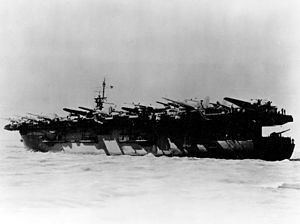Name USS Kadashan Bay Commissioned 18 January 1944 Launched 11 December 1943 Weight 7,925 tons Builder Kaiser Shipyards | Namesake Kadashan Bay Decommissioned 14 June 1946 Length 156 m Displacement 7.076 million kg | |
 | ||
Fate Scrapped 13 August 1959 Class and type Casablanca-class escort carrier Part of United States Pacific Fleet (1943–1946) Operations Mariana and Palau Islands campaign, Philippines Campaign, Battle off Samar | ||
USS Kadashan Bay (CVE-76) was a Casablanca class escort carrier of the United States Navy. She is named for Kadashan Bay Alaska.
Kadashan Bay was launched 11 December 1943 by the Kaiser Shipbuilding Company in Vancouver, Washington, under a Maritime Commission contract; sponsored by Miss Audrey Ackerman and commissioned 18 January 1944, Captain R. N. Hunter in command.
After shakedown Kadashan Bay departed San Diego 6 March 1944 on the first of two cruises to Espiritu Santo. She transported a total of 154 aircraft on these assignments before returning San Diego 13 May. Following repairs and training, the escort carrier sailed 10 July to join a carrier division at Pearl Harbor. One month later she sailed for Tulagi and final preparations for the September assault on the Palaus.
Kadashan Bay departed Tulagi 6 September and six days later her air group launched a pre-invasion air attack against enemy positions on Peleliu. Ground forces landed 15 September to gain control of the island as an air base to support the Philippine operation. After preparations were concluded at Manus, the escort carrier steamed toward the Leyte Gulf 14 October.
Arriving there 21 October she immediately commenced raids and strikes in support of troops ashore. Four days later one of her patrol planes, piloted by Ensign Hans L. Jensen, sighted the Central Force of the Japanese fleet off Samar. After reporting his sighting he launched an unsupported attack against the leading cruiser, beginning the famous battle off Samar. The carrier's air group launched three fighter and three torpedo strikes against Kurita's force. The flyers' courage and gallantry contributed greatly to the sound defeat from which the Japanese never recovered. Upon completion of this mission, Kadashan Bay steamed toward Manus, arriving 3 November.
As the action in the Philippines continued, Kadashan Bay's air group accounted for 11 planes in encounters with the enemy during mid-December. Preparations were now underway for the Luzon landings and the escort carrier rendezvoused with the main force 3 January 1945. She arrived off Luzon five days later and commenced an early morning air attack. That same morning a kamikaze aimed his death dive at Kadashan Bay. Despite repeated hits the enemy plane plunged into the ship amidships directly below the bridge. After an hour and a half of feverish damage control effort, fires and flooding were checked, and the escort carrier returned to Leyte on 12 January for temporary repairs before returning San Francisco 13 February for complete overhaul.
Kadashan Bay sailed for Pearl Harbor 8 April, arriving 14 April. She then commenced ferrying aircraft and passengers among the Pacific islands. During July the escort carrier was assigned as a replenishment carrier for the Third Fleet and was on her way from Pearl Harbor to begin her new duty when news of Japan's collapse came.
Kadashan Bay joined the "Magic-Carpet" fleet at Guam in September and arrived San Francisco 26 September with her first group of veterans. For the next three months the escort carrier made runs from Pearl Harbor, Guam, Okinawa, and China to return battle-weary Americans home. She arrived San Pedro 22 December from her last Pacific cruise, and departed San Diego 10 January 1946 for Boston. Kadashan Bay arrived Boston 29 January, decommissioned 14 June 1946, and was placed in the Atlantic Reserve Fleet there. She was reclassified CVU-76 on 12 June 1956 and scrapped 13 August 1959.
Kadashan Bay received two battle stars for World War II service.
